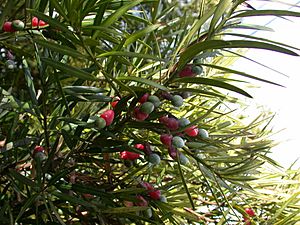Podocarpaceae facts for kids
Quick facts for kids Podocarpaceae |
|
|---|---|
 |
|
| Podocarpus macrophyllus foliage and mature seed cones | |
| Scientific classification |
|
| Kingdom: | Plantae |
| Clade: | Tracheophytes |
| Division: | Pinophyta |
| Class: | Pinopsida |
| Order: | Pinales |
| Family: | Podocarpaceae Endl. |
Podocarpaceae is a big family of plants. These plants are mostly conifers. Conifers are trees that usually have needles and cones, like pine trees. Most Podocarpaceae plants live in the Southern Hemisphere. This means they are found south of the equator.
There are about 156 different species in this family. They are all evergreen trees and shrubs. Evergreen means they keep their leaves all year round. This family has up to 19 different groups, called genera. Scientists think this family started growing a very long time ago. They believe it began on an ancient southern landmass called Gondwana.
Where Podocarpaceae Plants Live
These plants are part of the Antarctic flora. This means they are found in areas that were once connected to Antarctica. The places with the most different types of Podocarpaceae are:
- Australasia, especially New Caledonia, Tasmania, and New Zealand
- Malesia (a region in Southeast Asia)
- South America, mainly in the Andes mountains
Some types of Podocarpaceae also grow north of the equator. For example, some are found in Indochina and the Philippines. The Podocarpus group reaches as far north as southern Japan and southern China. In the Americas, it goes up to Mexico. Another group, Nageia, is found in southern China and southern India.
You can also find two groups of Podocarpaceae in sub-Saharan Africa. One is the widespread Podocarpus. The other is Afrocarpus, which is only found in Africa.
Unique Parasitic Plant
One very special plant in this family is Parasitaxus usta. It is the only known parasitic gymnosperm. A parasitic plant gets its food and water from another plant. Parasitaxus usta lives in New Caledonia. It grows on another plant from the Podocarpaceae family, called Falcatifolium taxoides.
See also
 In Spanish: Podocarpáceas para niños
In Spanish: Podocarpáceas para niños

